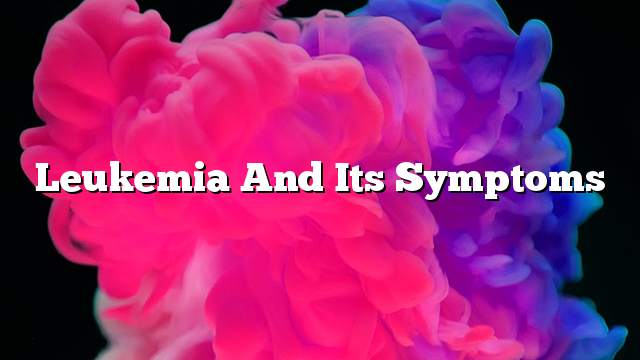the blood
Is the red fluid that passes through the blood vessels, contains white blood cells, red, plasma, platelets, proteins, and some other substances, transfers them to all parts of the body within the cardiovascular system, and transfers oxygen and food through the arteries from the heart to the rest of the body , Then takes carbon dioxide and waste from the cells to deliver them to the lung and kidneys to get rid of them through the veins.
- The following is a simplified explanation of blood contents and functions:
Blood contents and functions
- Red blood cells : Is the primary component responsible for carrying oxygen to tissues from the lungs, and carrying carbon dioxide from tissue to the lungs. Red blood cells are made up of an important protein called hemoglobin. Its function is to carry oxygen. It is associated with it. Red blood cells are called the blood clot. Red blood cells are formed in the bone marrow. When red blood cells fall, In anemia, the hemoglobin protein gives the red color to these pellets, whose life rate is only 120 daily.
- White blood cells : Its primary function is to protect the body, it is considered a line of defense of the body, and divided into white blood cells and branching into several types, each with its characteristics and functions. It does not contain any substance gained by color and hence gained its name, it appears without color, and its size is greater than red blood cells. It is divided into:
- Equivalent cells: Their function kills bacteria and appears as pus.
- Single cells: Their function is to kill germs, or any strange objects.
- Lymphocytes: Its function is to kill viruses and regulate the immune system, divided into lymphocytes, B cells, and lymphocytes.
- Platelets : It controls the bleeding and stop the wounds in case of injury, where the platelets accumulate above the wound and stop bleeding.
- Plasma : Water is the largest proportion of plasma up to 92% and consists of multiple compounds such as vitamins, hormones, proteins, minerals, and others.
blood cancer
Leukemia, or leukemia, is an abnormal growth of blood cells that are produced from the bone marrow, often white blood cells. These cells can not function properly. Cancer cells continue to grow and divide until natural cells collide and overcome them. Eventually the body is unable to fight infection, stop oxygen, and even transfer oxygen. There are several types of leukemia that vary depending on the type of cancer cells, and how rapidly the disease develops. The most common cancers are: acute lymphocytic leukemia (ALL), chronic lymphocytic leukemia (CLL), acute myeloid leukemia (AML) and chronic cystic leukemia.
Symptoms of leukemia
The signs and symptoms of leukemia depend on its type; slow-growing or chronic cancer may not show any symptoms at the beginning, and fast-growing or severe aggressive cancer leads to the emergence of severe symptoms in a short period of time from the beginning, and these symptoms result from the loss of blood cells For its function, or because of the accumulation of carcinogenic cells in the body parts, the most important of these symptoms are:
- Frequent and hot infections and tremors such as flu symptoms.
- Pain and swelling in different parts of the body.
- Headache, vomiting, loss of muscle control and epileptic seizures.
- Anemia or anemia.
- Bleeding occurs easily and abnormally, as does bleeding in the gums.
- Feeling tired and tired.
- The appearance of bruising is the object of attention.
- Loss of appetite and weight.
- Severe sweating especially at night.
- Difficult speech and speech.
- Bone pain.
- Liver and spleen hypertrophy.
- Inflammation of the lymph nodes.
Causes of leukemia
The real causes of leukemia have not yet been detected and may be due to multiple risk factors such as viral, genetic, immunological or environmental factors and other factors that contribute to the disease, including:
- Viral causes: Infection with some viruses, such as HIV, can increase the chance of cancer because of its effects on the genetic makeup of white blood cells, as well as the immunity of these patients.
- Chemicals such as gasoline, some petroleum products, hair dyes, and other toxins are a direct cause of this disease.
- Exposure to radioactive materials, strong radiation and short-frequency electromagnetic radiation.
- Genetic factors increase the chance of infection among twins if the other is infected with the disease, or that the family history of disease contains this disease.
- Cancer in people with Down syndrome increases.
- Chemotherapy and radiation for cancer.
- Smoking.
Diagnosis of leukemia
Diagnosis may be diagnosed by routine blood tests without symptoms and the diagnosis is confirmed by the following tests:
- Clinical examination to confirm signs and symptoms of the disease, if any.
- The most specialized blood tests.
- Biopsy of the bone marrow.
- Pull a sample of bone marrow fluid.
Treatment of leukemia
Blood cancer is treated according to its type, degree and spread. Generally, these are the most important treatments for this disease:
- Chemotherapy : By taking oral anticancer drugs or intravenous injection through a tube on cycles.
- Radiation therapy : Using a device that sends high-energy rays that destroy cancer cells, and stop their growth.
- New bone marrow transplantation : Doctors give the patient large doses of radiation destroy the bone marrow completely, and cultivate bone marrow properly.
- Biological therapy : Some substances are used to help the immune system to treat the disease.
